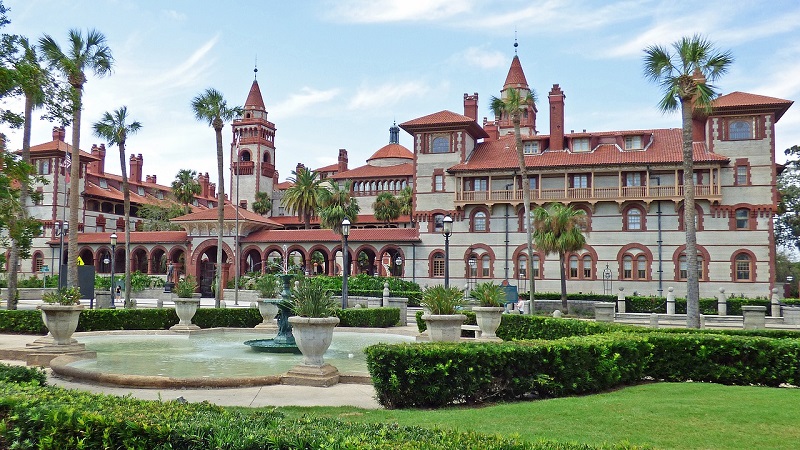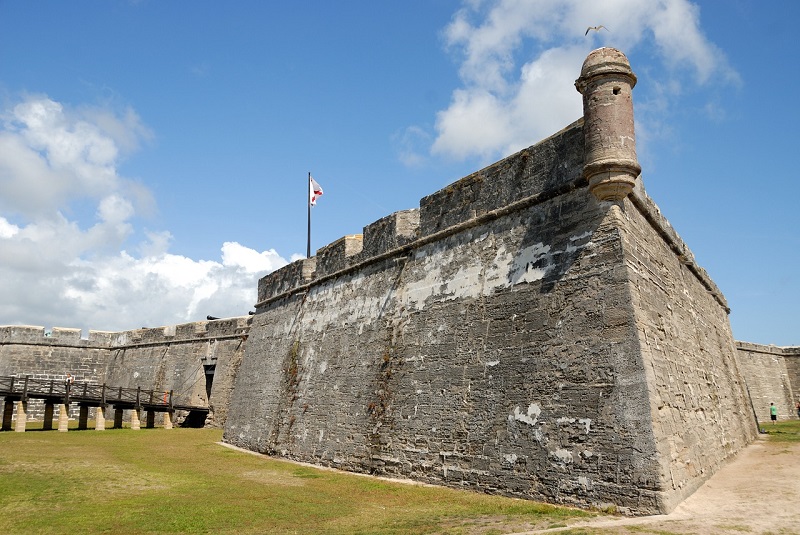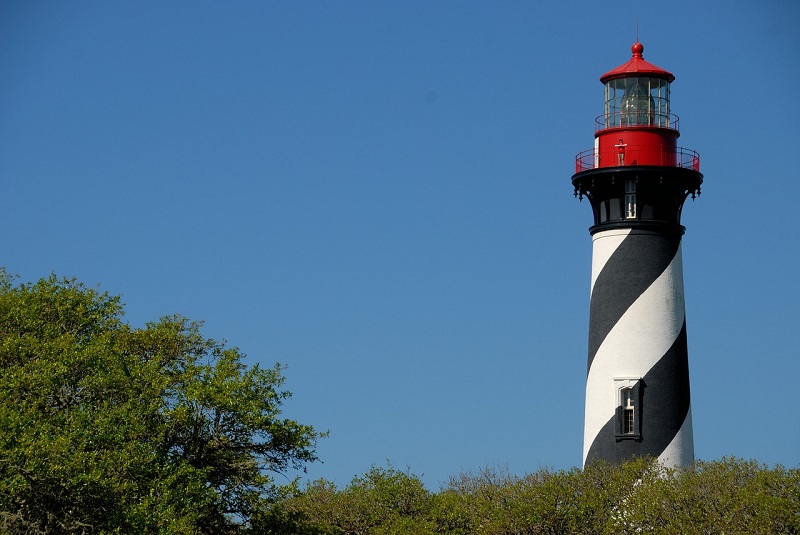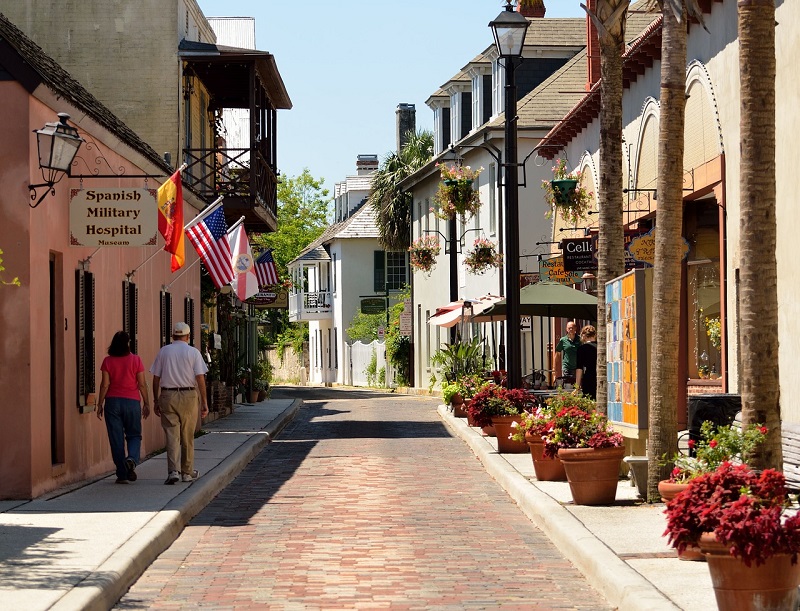9 St. Augustine Sites Where History and Culture Collide
As the oldest European settlement in the U.S., St. Augustine, Florida, has a rich history and sites visitors should explore. Eye-catching architecture, religious sanctuaries, walkable districts – this city has it all – all while honoring culture and modernity. Get ready to expand the bucket list and don’t miss these top St. Augustine sites.
Top 9 St. Augustine Sites for Culture and History

Flagler College
This private college welcomes visitors to walk its grounds, take pictures and enjoy guided tours. Once a hotel, this historic building features Spanish Renaissance architecture with intricate details.
Flager’s Legacy offers Flagler College tours for students and travelers who want to roam the courtyard, grand lobby, dining room and Woman’s Grand Parlor. Tours depart hourly from 10 a.m. to 2 p.m., and admission costs around $10 per adult. Children under 12 can participate for only $1 each. Due to availability, arrive an hour before tour time to purchase tickets or buy them in advance from the gift shop.
Cathedral Basilica of St. Augustine
Known as America’s first parish, Cathedral Basilica of St. Augustine welcomes visitors to tour and pray. The cathedral represents Catholic architecture, faith and practices, with a story dating over 450 years. In 2015, the cathedral was renovated to reflect its Spanish origins and showcase intricate design, statues, and art.
Guests should plan self-guided tours on Monday through Thursday beginning at 11 a.m., and groups should call ahead for an appointment. Guests may also attend Mass seven days a week.

Castillo de San Marcos
Is it a fort or a castle? The answer isn’t clear, but experts say its both. Castillo de San Marcos is the only extant 17th-century military construction and oldest masonry fortress in the U.S. While touring the monument, learn about its role in American history through exhibits and a short video. In addition, visitors enjoy live weapon demonstrations and hearing how colonists lived centuries ago.
Castillo de San Marcos is open to the public except on Thanksgiving and Christmas. Admission costs around $10 per person ages 16 and older, and guests under 15 get in free.
Mission of Nombre de Dios
Mission of Nombre de Dios dates back to St. Augustine’s original settlement in 1565. It was here when Pedro Menéndez de Avilés landed on this site and claimed it for Spain and the Church. Today, the mission and grounds serve as a place for people to worship and learn.
Take a walking tour and see a church, statues, plaques, and artifacts that showcase the area’s historical significance. The grounds have exhibits located throughout as well as an indoor museum. Don’t forget to stop by the Great Cross, a 208-foot cross that stands over Matanzas River. After exploring the grounds, attend Mass, which is held at noon on Monday through Saturday.

St. Augustine Lighthouse and Maritime Museum
Dating back to the late 1800s, St. Augustine Lighthouse and Maritime Museum offers a glimpse into Spanish-American history. This top among St. Augustine sites welcomes nearly 250,000 people a year to tour interactive exhibits and see artifacts. While visiting, head to the 1876 Keepers’ House, play in the shipyard, learn about wooden boat building, and go on a scavenger hunt.
In addition to general admission activities, guests also book a nighttime ghost tours. These weekend-only tours last around two hours, and investigators can rent Electromagnet field readers. Admission prices to the lighthouse and museum vary depending on activities.
Fort Matanzas National Monument
Fort Matanzas has stood tall protecting St. Augustine’s southern river approach since the 1700s. The site offers a .06-mile nature trail where people view wildlife and plants native to the area.
Or get a free pass from Matanzas Visitor Center and ride the ferry. Each ferry carries 35 people and drops them off at the fort where they learn about history and take photos. Other things to do include browsing exhibits, hearing stories and watching a quick movie.

Old City
Those who want to immerse in culture should explore the historic district, also known as Old City. The area houses many historical St. Augustine sites, as well as modern attractions, museums and shopping. Once the sun sets, catch a show at St. Augustine Amphitheater, attend a festival or browse local art during First Friday Art Walk held monthly.
While walking the streets, pop into restaurants and retailers for food and gifts. Old City houses antique shops — which may take up an entire weekend. Other shops sell apparel, jewelry, collectibles, books, music and souvenirs.
St. George Street
Situated in downtown St. Augustine, find St. George Street – one of the most popular and walkable streets in the city. This pedestrian-only area houses art galleries, attractions, restaurants and shops, and doubles as a historic attraction.
Top sites on St. George Street include the oldest schoolhouse in St. Augustine, historic Pena-Peck House built in 1750, and The Spanish Bakery, a favorite for treats and lunch. St. George Street serves as the main thoroughfare through downtown, so expect crowds during busy seasons.
Colonial Quarter
While on St. George Street, don’t forget to spend time at Colonial Quarter. This attraction takes people back in time during guided and self-guided tours, live demonstrations and events. During Living History Tour, learn how settlers lived, worked, played and managed attacks. Visitors even meet blacksmiths and see muskets in use.
Before and after the tour, shop and eat. Then attend a concert in Colonial Oak Music Park, an outdoor venue perfect for intimate shows and live entertainment.
After reading about these top St. Augustine sites, search vacation rentals near St. Augustine beaches.
Traveling with children? Check out the top St. Augustine kids attractions.
